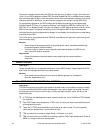
36 S-ICX (International) issued October 2000 S-ICX-50-200
HUNT GROUPS
Description:
Calls can be automatically transferred to hunt groups, which consist of member positions #1
through #20 to which extensions can be assigned (for example, Extension 201 is Member #1,
Extension 314 is Member #2, Extension 268 is Member #3, ... Extension 107 is Member #20).
For each hunt group, you can choose one of four different automatic hunting methods in
programming:
❣ Pilot Terminal hunting. When a call is directed to the pilot number of the hunt group,
Member #1 is tried first. Hunting proceeds forward through the sequential members to the
end of the hunt group. If Member #20 (last member) doesn’t answer, the call then returns to
Member #1 again, and the hunt cycle is repeated until a member answers the call.
❣ Pilot Distributed hunting. When a call is directed to the pilot number of the hunt group, the
next sequential member after the member who received the last call, is tried first. Hunting
then proceeds forward from that member, through the sequential members to the end of the
hunt group. If Member #20 (last member) doesn’t answer, the call then goes to Member #1,
and hunting proceeds forward through the hunt group again. The hunting cycle (Member #1
through Member #20) repeats until a member answers the call.
❣ Circular hunting. This is for direct calls to member extensions (no pilot number involved).
Starting at the member extension receiving the call, hunting proceeds forward through the
sequential members to the end of the hunt group. If Member #20 (last member) doesn’t
answer, the call then goes to Member #1, and hunting proceeds forward through the hunt
group again. The hunting cycle (Member #1 through Member #20) repeats until a member
answers the call.
❣ Switchback hunting. This is also for direct calls to member extensions (no pilot number
involved). Starting at the member extension receiving the call, hunting proceeds forward
through the sequential members to the end of the hunt group. It then returns to the receiving
(originally called) member, and hunts backward through the members to the beginning of
the hunt group. Then it returns to the receiving member again, and hunts forward. This
return-forward/return-backward hunt cycle repeats until a member answers the call.
Twelve (12) hunt groups are available. Each hunt group can have its own unique characteristics
such as hunting method, no-answer timeout/destination, etc. In other words, via programming
you can control how long a Member will ring before the call moves to the next Member, and also
how long before (or whether) the call will be transferred out of the Hunt Group to an extension or
to another Hunt Group.
Benefits:
• Allows calls to be distributed among a group of extensions where a group of people
answer the same calls.
• Voice mail systems use hunt groups to distribute calls.
Applications:
• Customer service departments, sales & marketing divisions, technical support
groups, etc.


















